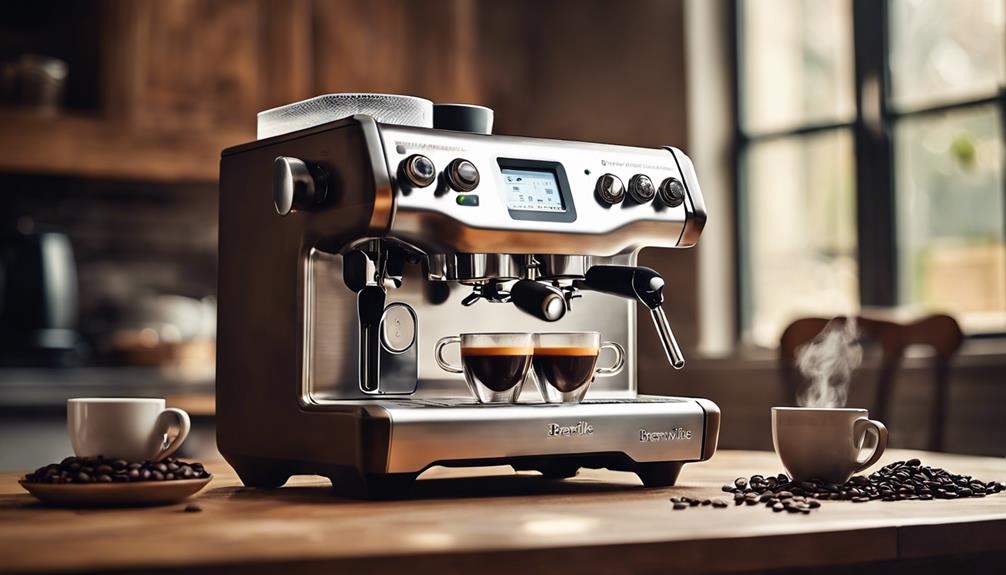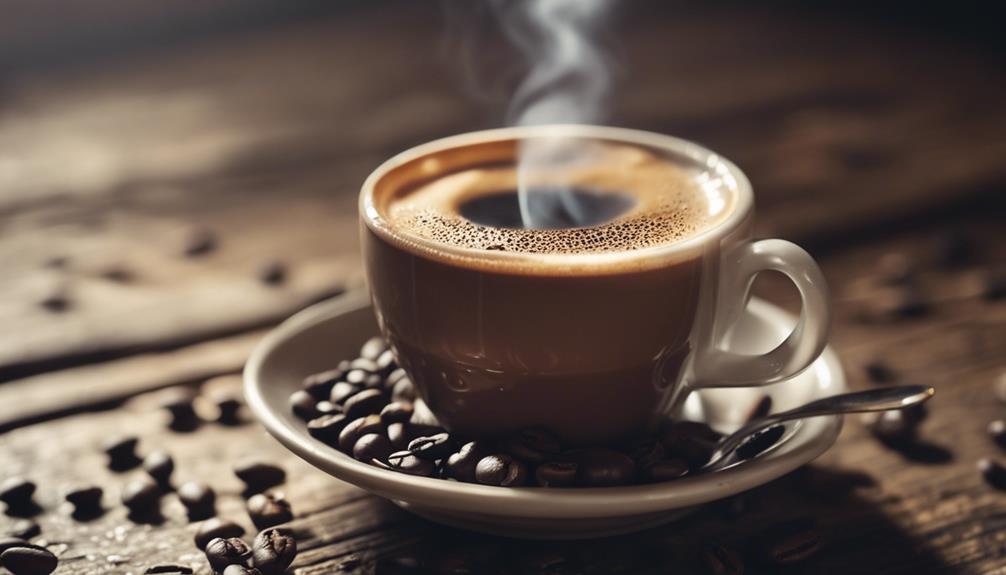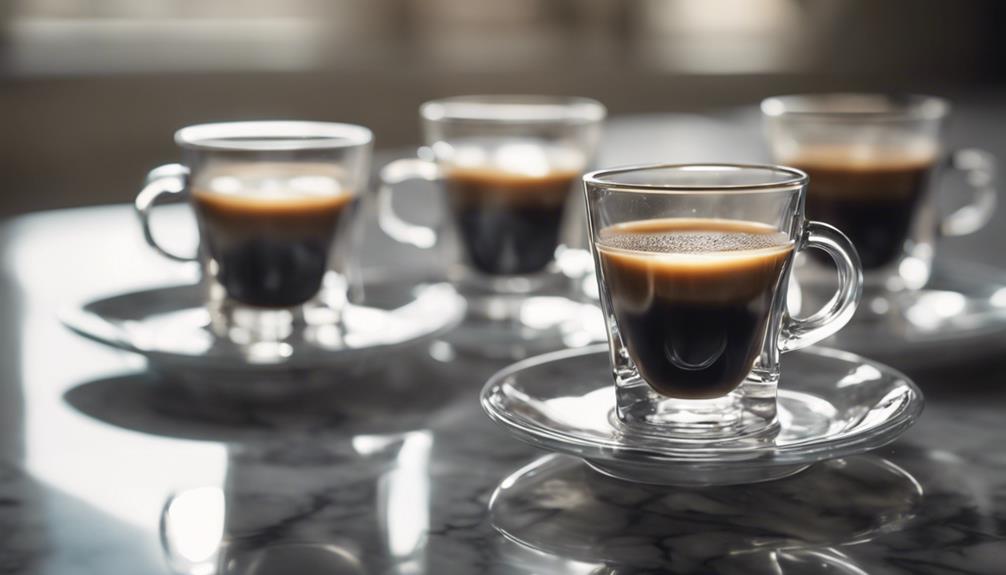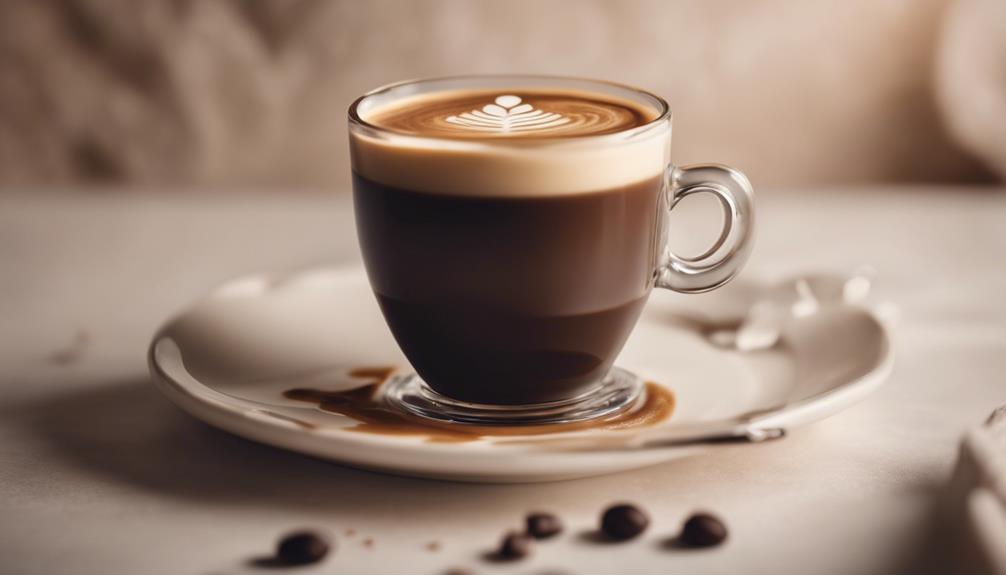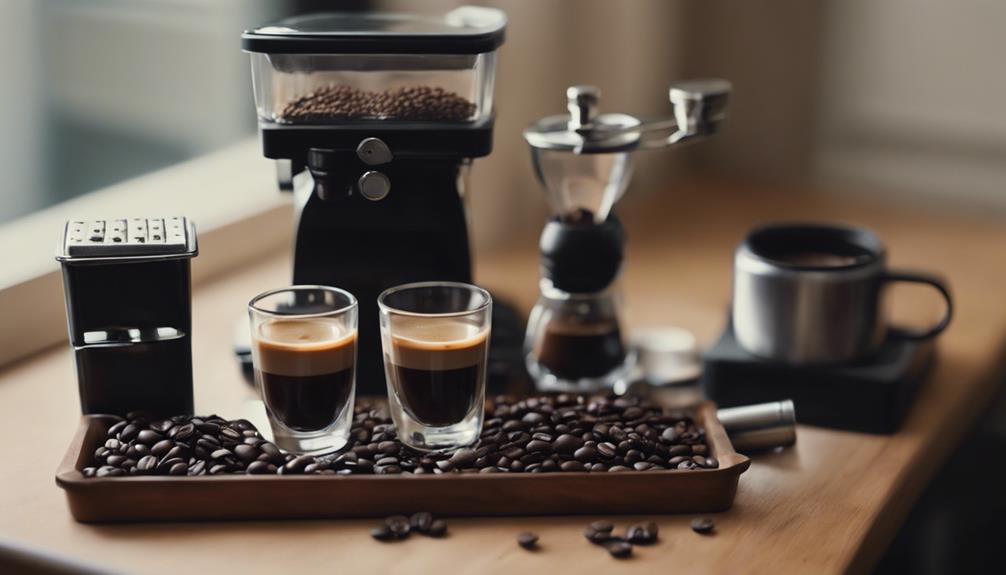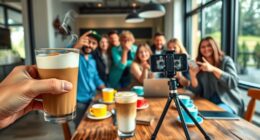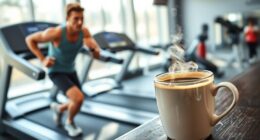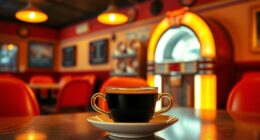When comparing Vietnamese coffee to espresso, you will notice distinctive differences. Vietnamese coffee is known for its intense and bold flavor with hints of nuttiness and chocolate, sweetened by condensed milk. It is made using robusta beans, which give it a strong taste. Brewed slowly with a phin filter, it offers a robust experience. On the other hand, espresso has a concentrated flavor with rich crema, made from arabica and robusta beans. It is prepared under high pressure for a quick caffeine boost. The unique flavor profiles, brewing techniques, and cultural influences make these coffees stand out, showcasing their individual characteristics.
Key Takeaways
- Vietnamese coffee uses robusta beans for bold flavor, while espresso blends arabica and robusta for a balanced taste.
- Vietnamese coffee brewed with a phin filter offers a strong, slow-drip extraction, while espresso is a high-pressure, concentrated shot.
- Robusta beans in Vietnamese coffee double the caffeine content compared to arabica, providing a potent energy boost.
- Vietnamese coffee is traditionally served with sweetened condensed milk, offering a creamy and indulgent experience, unlike the pure shot of espresso.
- Cultural significance: Vietnamese coffee reflects Vietnam's bold flavors and unique brewing techniques, while espresso represents European intensity and richness.
Flavor Profiles
Compare the intense and bold flavor profiles of Vietnamese coffee and espresso to understand their distinct taste characteristics.
Vietnamese coffee boasts an intense and bold flavor, striking a unique combination of bitterness and sweetness. The nutty and chocolatey notes of robusta beans shine through, adding depth to each sip. The addition of sweetened condensed milk helps balance the strong and bitter taste, creating a harmonious blend of flavors.
On the other hand, espresso offers a concentrated and intense flavor experience, ranging from bitter undertones to subtle sweetness. The rich crema on top adds a luxurious touch to the overall profile. Espresso showcases a mix of arabica and robusta beans, each contributing nuanced flavors to the final brew.
While Vietnamese coffee emphasizes the robust and distinctive qualities of the robusta bean, espresso highlights the complexity and subtleties of its blend. Both beverages provide a rich and intense coffee experience, yet their flavor profiles remain distinctly different due to their brewing methods and choice of beans.
Coffee Beans Used

Vietnamese coffee and espresso utilize different types of beans to create their distinct flavors. Robusta beans are key in Vietnamese coffee, offering a strong and bold taste, while espresso blends both arabica and robusta for a balanced flavor profile.
The choice of coffee beans in each brew greatly influences the caffeine content and overall taste experience.
Bean Varieties
Robusta beans, favored for their boldness and high caffeine content, play a central role in Vietnamese coffee. These beans are known for their intense flavor, contributing to the robust and strong taste characteristic of Vietnamese coffee.
On the other hand, espresso blends typically combine arabica and robusta beans to achieve a balanced flavor profile. Arabica beans are favored for their nuanced flavors, while robusta beans add depth and caffeine kick to the brew. Espresso beans, including this blend, are often roasted darker to enhance the rich and concentrated flavors extracted during the brewing process.
The choice of coffee beans is important as it greatly impacts both the flavor profile and caffeine content of the final cup of Vietnamese coffee or espresso. Whether you prefer the boldness of robusta or the complexity of arabica, the type of beans used plays an essential role in determining the overall taste and experience of your coffee.
Roasting Methods
For Vietnamese coffee, the roasting process plays a vital role in accentuating the bold flavors of the robusta beans, resulting in a distinct earthy and nutty profile. Robusta beans are known for their bolder flavor and higher caffeine content, making them ideal for this intense brew.
The dark roast applied during the roasting process brings out the robusta beans' natural characteristics, creating a coffee with a strong and robust taste.
On the other hand, espresso beans, which typically blend arabica and robusta beans, undergo a different roasting method. Espresso's dark roast aims to enhance sweetness and bitterness, resulting in a concentrated and intense flavor profile.
The roasting process plays an essential role in determining the final taste of the coffee, whether it be the bold and earthy notes of Vietnamese coffee or the rich crema and full-bodied shot of espresso.
Each method highlights the unique qualities of the beans, offering coffee enthusiasts a diverse range of flavors to enjoy.
Brewing Methods
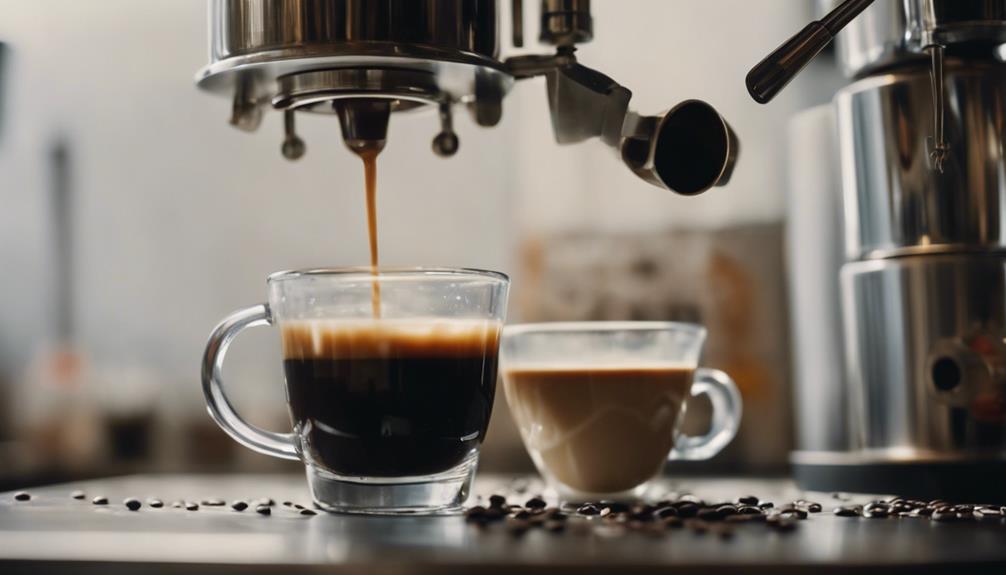
When comparing Vietnamese coffee and espresso, it's crucial to take into account the brewing methods. Vietnamese coffee is typically made using a slow-drip phin filter, resulting in a strong and intense flavor.
In contrast, espresso is brewed under high pressure, creating a concentrated and bold shot of coffee.
Brewing Equipment Differences
In comparing Vietnamese coffee to espresso, the brewing equipment differences lie in the distinct brewing methods employed for each type of coffee.
- Vietnamese coffee is traditionally brewed using a phin filter and a slow-drip method, allowing for a strong and bold flavor profile.
- Espresso, on the other hand, is made using an espresso machine that operates under high pressure levels, resulting in a concentrated and intense flavor.
- The phin filter used for Vietnamese coffee facilitates a longer brewing process compared to the quick shot of espresso, enhancing flavor extraction.
- Espresso machines require a finer grind of coffee beans to guarantee proper extraction, while the phin filter uses coarser grounds for a simpler brewing process.
- Vietnamese coffee and espresso also vary in brewing time, with Vietnamese coffee taking several minutes to drip, while espresso is brewed rapidly in about 25-30 seconds.
Flavor Profile Variances
The brewing methods for Vietnamese coffee and espresso distinctly shape their flavor profiles. Vietnamese coffee, often using robusta beans, delivers a strong and bold taste with a hint of sweet creaminess. On the other hand, espresso, crafted from a blend of arabica and robusta beans, offers a rich and intense flavor due to its high-pressure brewing method.
Let's compare the flavor profile variances of Vietnamese coffee and espresso:
| Aspect | Vietnamese Coffee | Espresso |
|---|---|---|
| Bean Compositions | Primarily Robusta beans | Blend of Arabica and Robusta beans |
| Brewing Method | Phin filter with slow-drip technique | High-pressure extraction with a fine grind size |
| Flavor | Strong, bold, with sweet creaminess | Rich, intense, velvety texture with thick crema |
The different bean compositions and brewing methods contribute significantly to the distinct flavors of Vietnamese coffee and espresso.
Caffeine Content
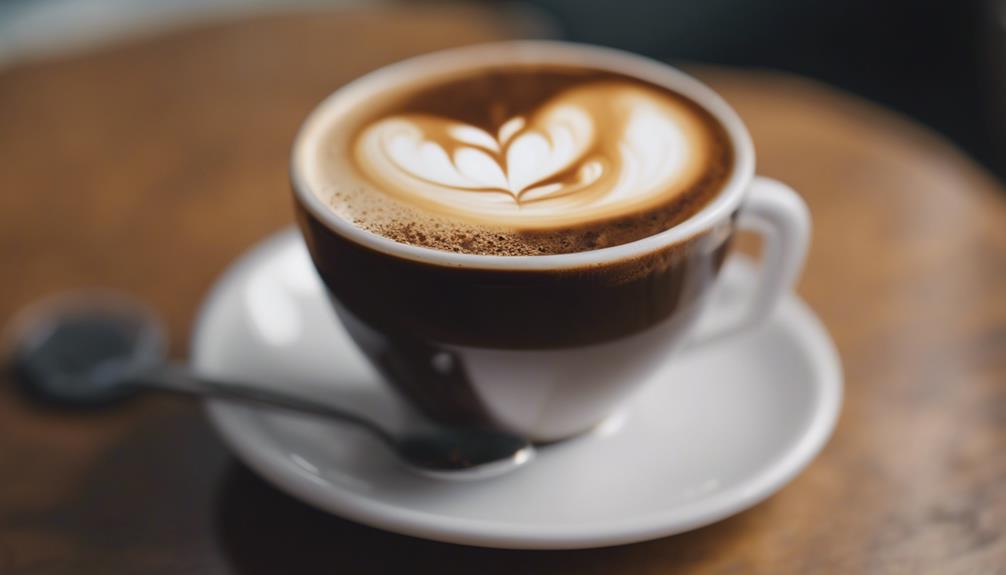
When comparing Vietnamese coffee and espresso regarding caffeine content, several key differences emerge:
- Robusta beans contain nearly twice the caffeine content of arabica beans, contributing to the higher caffeine levels in Vietnamese coffee.
- The slow drip brewing method of Vietnamese coffee using a phin filter allows for efficient caffeine extraction, resulting in a potent caffeine kick.
- Espresso boasts a higher caffeine concentration per ounce compared to Vietnamese coffee, delivering a quick and intense caffeine hit.
- Vietnamese coffee offers a more sustained energy boost due to its larger serving size, providing a gradual release of caffeine over time.
- Both Vietnamese coffee and espresso provide distinct caffeine experiences, with Vietnamese coffee emphasizing a bold, robust flavor alongside its caffeine content, while espresso focuses on a concentrated, rich coffee shot.
Serving Styles

Experience a contrast in serving styles between Vietnamese coffee and espresso. Traditional Vietnamese coffee is typically prepared with the phin filter brewing method, resulting in a slow extraction process that allows the flavors to develop fully. It's then served with sweetened condensed milk, offering a creamy and sweet taste profile that sets it apart from espresso.
In contrast, an espresso shot is served as a concentrated form of coffee without any additives, showcasing its intense and bold flavor.
While espresso is often consumed for a quick caffeine boost due to its high-pressure brewing method, Vietnamese coffee is enjoyed for the unique taste experience it provides. The distinct serving styles of these two beverages cater to different preferences, with Vietnamese coffee offering a more leisurely and indulgent drinking experience compared to the quick shot of espresso.
Both options provide coffee enthusiasts with a range of choices to suit their desired flavor profiles and caffeine needs.
Cultural Significance

Explore the cultural significance of Vietnamese coffee and espresso, revealing their historical ties and regional influences.
- Vietnamese coffee is deeply intertwined with Vietnamese culture, boasting bold flavors and unique brewing methods like the phin filter.
- Espresso, originating from Italy, holds a special place in European coffee culture for its intense and concentrated flavors.
- Both Vietnamese coffee and espresso play crucial roles in their respective regions, reflecting the preferences and traditions of local communities.
- Vietnamese coffee celebrates the robusta beans grown in Vietnam, while espresso showcases a blend of arabica and robusta beans in a darker roast.
- The cultural significance of Vietnamese coffee stems from its rich history linked to French colonization, while espresso embodies the essence of Italian coffee craftsmanship.
These beverages serve as more than just drinks; they're symbols of tradition, history, and craftsmanship, connecting people through the shared experience of savoring intense flavors in a cup.
Taste Characteristics

Highlighting the distinct flavor profiles of Vietnamese coffee and espresso sheds light on their unique characteristics and brewing methods. Vietnamese coffee, made with robusta coffee beans, is renowned for its bold flavor with earthy and nutty undertones. The addition of sweetened condensed milk brings a creamy sweetness that contrasts the strong coffee base. Brewed using a phin filter, Vietnamese coffee undergoes a slow extraction process, resulting in a full-bodied and rich taste.
On the other hand, espresso offers an intense flavor experience, with a rich crema and a concentrated shot. The phin brewing method in Vietnamese coffee, paired with robusta beans, provides a depth of flavor that sets it apart. In contrast, espresso showcases the blend and roast nuances through a quick, high-pressure extraction.
Vietnamese coffee strikes a balance between strong and sweet flavors, appealing to those seeking a flavor-packed experience, while espresso caters to individuals in search of a quick and intense caffeine boost.
Preparation Techniques

When preparing Vietnamese coffee, a phin filter is traditionally used for its slow-drip extraction process. This method allows for a strong and rich brew to develop gradually, enhancing the flavors of the coffee beans.
Here are some key differences in the preparation techniques between Vietnamese coffee and espresso:
- Vietnamese coffee utilizes a phin filter for the slow-drip extraction process.
- The slow-drip extraction in Vietnamese coffee results in a rich flavor profile.
- Vietnamese coffee often includes sweetened condensed milk, adding a creamy sweetness to the bold brew.
Espresso, on the other hand, is made by forcing hot water through finely-ground coffee beans under high pressure. It is known for its intense and concentrated flavor due to the high-pressure extraction.
These distinct preparation techniques contribute to the unique taste profiles of Vietnamese coffee and espresso, making each a delightful experience for coffee enthusiasts.
Global Popularity

Vietnamese coffee's deep roots in Vietnamese culture contrast with espresso's widespread global popularity, showcasing the diverse reach of these distinct coffee styles.
While Vietnamese coffee holds a special place in Vietnamese daily life, espresso has gained immense popularity worldwide, becoming a staple in cafes across the globe.
The unique flavors and brewing methods of Vietnamese coffee have started to capture international attention, but espresso remains a top choice for many coffee enthusiasts.
Both Vietnamese coffee and espresso offer distinct taste profiles and preparation techniques that have contributed to their global recognition.
Espresso, originating from Italy, boasts an intense and concentrated flavor with a rich crema, appealing to those who prefer a quick and strong shot of coffee.
On the other hand, Vietnamese coffee provides a slower, more ritualistic brewing process, offering a bold and robust taste with a sweet, creamy undertone that sets it apart on the global stage.
Frequently Asked Questions
What Makes Vietnamese Coffee Different From Regular Coffee?
Vietnamese coffee stands out from regular coffee due to its robusta beans, delivering a bold taste and high caffeine kick.
The unique brewing method with a phin filter and sweetened condensed milk creates a rich sensory experience distinct from the classic brew.
This harmonious blend of strong, bitter notes and creamy sweetness sets Vietnamese coffee apart, offering a delightful twist on your usual cup.
What Makes Vietnamese Coffee Thick?
To make Vietnamese coffee thick, the slow drip brewing method of the phin filter extracts rich flavors and oils from the coffee grounds.
The use of robusta beans enhances the texture and caffeine content.
Serving it with sweetened condensed milk adds creaminess.
The strong, dark coffee combined with sweet milk creates a unique thickness.
The phin filter's slow extraction process results in a concentrated brew, hallmarking Vietnamese coffee's thickness.
Can I Make Vietnamese Coffee in an Espresso Machine?
Yes, you can use an espresso machine to make Vietnamese coffee, but it may not capture the traditional flavors.
The slow-drip method of Vietnamese coffee requires a phin filter, which differs from the high-pressure extraction of espresso machines.
While possible, using an espresso machine mightn't yield the same taste profile as the authentic Vietnamese brewing technique.
For the best experience, consider using a phin filter or traditional brewing methods.
How Much Stronger Is Vietnamese Coffee Than Regular Coffee?
Vietnamese coffee packs a punch with nearly double the caffeine of your regular cup. The slow drip method extracts that caffeine like a pro, giving you a brew that's stronger than your average joe.
What Makes Vietnamese Coffee Different from Lungo Coffee?
Vietnamese coffee is known for its strong, bold flavor due to the unique brewing technique using a metal drip filter. On the other hand, Lungo coffee is a long shot of espresso, resulting in a more diluted and milder flavor. These key differences between lungo and espresso create distinct coffee experiences for enthusiasts.
What Makes Vietnamese Coffee Different from Black Coffee and Espresso?
Vietnamese coffee, unlike black coffee and espresso, is typically brewed with sweetened condensed milk, giving it a unique creamy texture and a sweet flavor. This sets it apart from the traditional bitterness of black coffee and the strong, concentrated taste of espresso. The espresso vs black coffee differences are quite distinct when compared to Vietnamese coffee.
Conclusion
To sum up, while both Vietnamese coffee and espresso offer unique flavors and brewing methods, they differ in various aspects such as coffee beans used, caffeine content, and cultural significance.
One interesting statistic to note is that espresso is the preferred choice for many coffee lovers worldwide, with over 2 billion cups consumed daily.
Understanding the distinctions between these two popular coffee options can help you appreciate the rich diversity of coffee culture around the globe.

